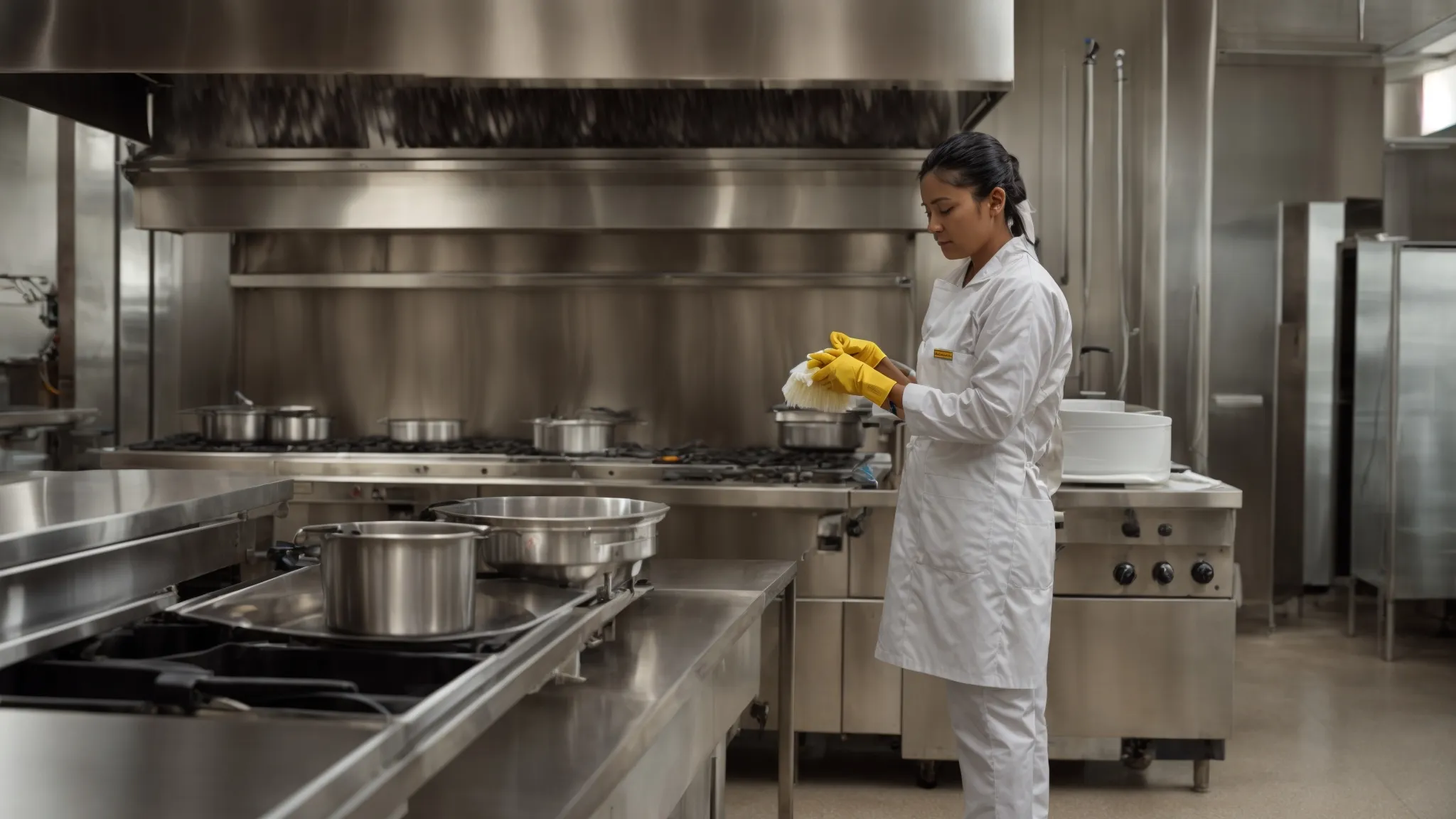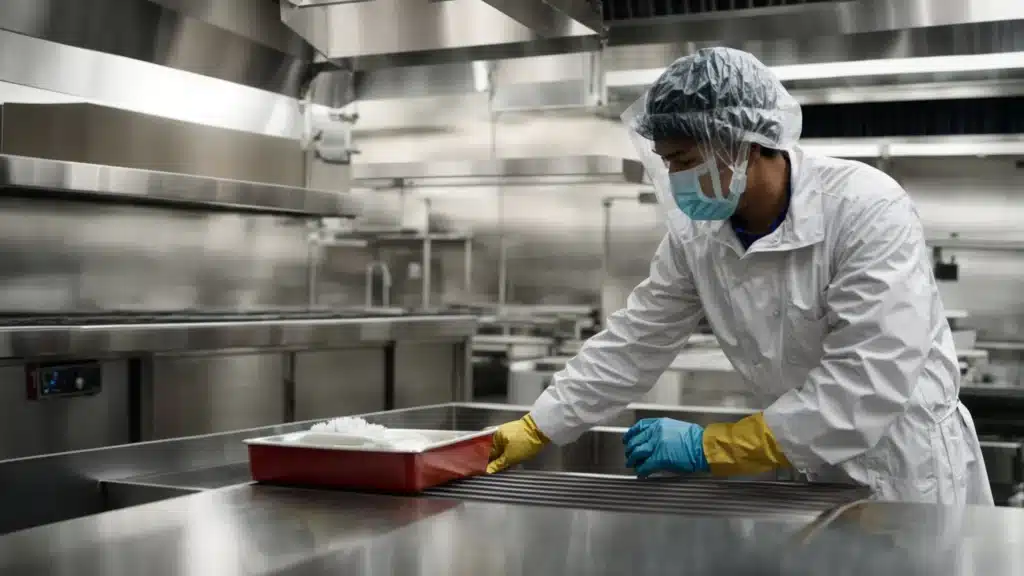Step-by-Step Procedures Involved in Kitchen Hood Cleaning
Step-by-Step procedures involved in kitchen hood cleaning:
Navigating the labyrinth of kitchen cleanliness, the task of hood cleaning stands as a guardian, protecting against the dangers of grease fires and ensuring a pathway for clean air.
Given the pivotal role it plays, adopting efficient techniques for hood cleaning transcends mere chores into an art form—a ritual that safeguards the heart of the commercial kitchen and breathes life back into its veins.
With the delicate dance between removing stubborn grease and preserving the integrity of the equipment, selecting the right approach becomes crucial.
In this guide, we embark on a journey through the meticulous process of kitchen hood cleaning, outlining the steps and solutions that promise not just cleanliness, but a rejuvenation of your kitchen’s soul.
Keep reading to uncover the secrets of transforming a daunting task into a triumph of hygiene and safety.
Key Takeaways
- Turning Off All Kitchen Appliances Before Cleaning Ensures Safety and a Focused Cleaning Process
- Protective Coverings Are Essential to shielding kitchen areas From Grease and Water During Cleaning
- Choosing the Correct Degreaser Based on the Hood’s Material Is Crucial to Avoid Damage
- A Thorough Soaking, Rinsing, and Drying Process for Filters Is Key to Restoring Their Function and Efficiency
- A Simple Paste of Baking Soda and Water Can Effectively Tackle Stubborn Grease Stains Without Harsh Chemicals
Preparing Your Kitchen for Hood Cleaning

Embarking upon the journey of kitchen Hood Cleaning, it’s crucial to navigate the preliminary steps with precision and care, much like a maestro tuning instruments before a symphony.
This initial orchestration involves two critical undertakings: the cessation of all kitchen appliances and the protection of the surrounding areas from the inevitable invasion of grime and water.
Deactivating every piece of equipment not only safeguards against unwanted accidents but also creates a safer environment for the cleaning process to unfold.
Simultaneously, draping nearby surfaces with protective coverings acts as a shield, guarding against the splashes and spills that accompany the thorough scrubbing of your kitchen’s respiratory system.
This preliminary stage sets the stage for a cleaning encore that leaves your kitchen’s hood in a state of pristine serenity, laying the groundwork for the systematic and efficient cleaning techniques that follow.
Turn Off All Kitchen Appliances Before Cleaning
Before embarking on the deep dive into the realm of hood cleaning, ensuring the cessation of all kitchen devices is paramount. Like a conductor silencing the orchestra for a moment of pure clarity, turning off every appliance ensures the stage is set immaculately, free from the humming distractions of ovens, dishwashers, and refrigerators. This silence not only acts as a safety measure but also paves the way for a focused and undisturbed cleaning performance.
Engulfed in the tranquility of a kitchen at rest, the cleaning professionals can maneuver with precision around the cooktop, stove, and dishwasher. With the electricity at bay, the risk of accidents involving water and power is negated, allowing the team to deploy their tools and solutions, such as degreasers and scrub brushes, in a safe haven. This preparatory step is akin to laying down a clean canvas, eagerly awaiting the first stroke of the brush.
Cover Nearby Surfaces to Protect From Grime and Water
In the ballet of kitchen hood cleaning, the stage extends beyond the hood itself, reaching the surrounding areas vulnerable to the splatter of grease and water: countertops, appliances, and floors. Like a cloak of invisibility, protective coverings serve to shield these surfaces from the chaos of cleaning, preserving their integrity and appearance.
| Step | Action | Reason |
|---|---|---|
| 1 | Cover Countertops | Protects against grease and water damage |
| 2 | Shield Appliances | Maintains cleanliness, prevents moisture ingress |
| 3 | Guard Floors | Avoids slippery conditions, preserves flooring |
Once every actor in the kitchen – the stoves, sinks, and refrigerators – stands veiled under the protection of durable plastic or cloth, the true cleaning symphony can commence. This preparatory act, simple yet crucial, ensures that the aftermath of a hood cleaning session is nothing but a revitalized kitchen, without collateral damage to its surrounding entities.
Now that your kitchen stands ready for transformation, the adventure shifts towards uncovering the ideal cleaning concoctions. This pivotal choice beckons, promising to elevate your hood’s sparkle to unprecedented heights.
Selecting the Right Cleaning Solutions for Your Hood

In the artistry of kitchen hood cleaning, selecting the right cleaning solutions transcends mere choice; it borders on alchemy.
The journey towards a spotlessly clean hood commences with an astute evaluation of degreasers, and their compatibility with your hood’s material—a harmonious pairing that ensures the hood’s integrity while banishing every speck of grease.
Armed with the ideal solution, the meticulous process of mixing it in accordance with the manufacturer’s guidelines unfolds.
This pivotal step guarantees the potion’s potency, ready to tackle the relentless grease without compromise.
Understanding the unique dance of solution selection and preparation is essential, setting the stage for a performance where cleanliness and safety take the spotlight.
Evaluate Different Degreasers Based on Your Hood Material
The selection of degreasers for kitchen hood cleaning ventures goes far beyond mere preference, delving into the realm of material compatibility. Aluminum, stainless steel, and plastic hoods each beckon for a degreaser that not only cleans but cherishes the material, preventing corrosion or damage.
Embarking on this thoughtful selection process, professionals often lean towards environmentally friendly solutions for aluminium and stainless steel hoods, ensuring a vigorous yet gentle cleanse. For plastic components, a milder, less abrasive degreaser takes centre stage, guarding the material against the harshness of potent chemicals.
Mix Your Chosen Solution According to the product instructions.
Mixing your chosen cleaning solution according to the product instructions is not just a step; it’s an essential ritual in the alchemy of hood cleaning. This pivotal act ensures that the concoction’s strength is perfectly matched to tackle the grime without harming the hood’s material: a perfect balance of efficacy and safety.
Without adherence to the precise ratios and mixing methods recommended by the manufacturer, the risk of reducing the solution’s cleaning power—or worse, damaging the hood—looms large. Following these guidelines is akin to following a treasure map: deviate from the path, and the desired outcome remains elusive.
- Review the cleaning solution’s label for mixing instructions and safety precautions.
- Measure the correct amounts of solution and water, if dilution is required.
- Combine the components gently to create a homogenous mixture ready for action.
Armed with the perfect arsenal of cleaning solutions, the journey to a gleaming hood just begun. Let’s dive into the step-by-step guide that will transform your hood’s exterior from grimy to sparkling.
Step-by-Step Guide to Scrubbing the Hood Exterior

Embarking on the transformative process of scrubbing the hood exterior demands a blend of precision and gentleness, mirroring the care of an artist adding delicate touches to a masterpiece.
The commencement of this cleaning ritual unfolds with the thoughtful application of the chosen cleaning solution, utilizing a non-abrasive sponge to caress the surface, ensuring that the integrity of the kitchen hood remains unscathed.
The art of gentle scrubbing in circular motions, followed by a meticulous wipe down with a microfiber cloth, not only elevates the hood’s aesthetic but also reinstates its function, allowing it to breathe freely once more.
This methodical approach ensures that every inch of the hood’s exterior is bathed in cleanliness, setting a new standard for kitchen hygiene.
Apply Cleaning Solution With a Non-Abrasive Sponge
Embarking on the meticulous journey of restoring the hood’s lustre, the initial step involves the tender application of a cleaning solution using a non-abrasive sponge. This sponge, akin to a gentle hand, ensures that the hood’s surface encounters neither scratches nor undue harshness, preserving the aesthetic appeal and structural integrity of this pivotal kitchen apparatus.
The act of caressing the hood with the sponge soaked in the chosen detergent marks the beginning of a transformation. It’s a crucial phase where the solution begins its work, breaking down the grease and grime accumulated over time, without introducing any abrasives that might tarnish or damage the surface. This thoughtful technique ensures that the hood remains in pristine condition, both functionally and visually, as it resumes its duty of safeguarding the kitchen’s air quality.
Gently Scrub in Circles and Wipe Down With a Microfiber Cloth
Upon the application of the cleaning solution, the next vital step involves a gentle scrubbing motion, executed in deliberate circles. This technique, resembling the tender movements of a potter shaping clay, ensures that every corner of the hood’s exterior is reached without imposing any abrasions. The spherical motions create a dance between cleaner and surface, facilitating deeper penetration of the solution into the grease and dirt.
Following the thorough scrubbing phase, a pristine finish is achieved by meticulously wiping the hood down with a microfiber cloth. This cloth, softer than a whisper, acts to absorb the loosened grime while polishing the surface to a gleam that rivals the morning sun. It’s this final touch that restores the hood’s exterior, allowing it to function optimally and stand as a testament to the kitchen’s cleanliness and care.
Shifting gears, let’s dive beneath the surface. Prepare for an odyssey into the intricate world of deep cleaning your kitchen hood filters.
Deep Cleaning the Filters of Your Kitchen Hood

Transitioning to the heart of the kitchen hood’s cleansing journey, attention turns toward the crucial element of filtration – where grease and debris collect, silently impeding airflow and efficiency.
Deep cleaning the filters of your kitchen hood is not merely a task but a requiem for the accumulated layers of grime, a procedure that breathes life back into the very lungs of your kitchen.
This section illuminates the path through detailed methodologies, guiding you from the initial removal and pre-soaking of filters in a potent degreaser solution, to the thorough rinse and the all-important drying phase.
Each step is meticulously designed to strip away the vestiges of culinary endeavors, ensuring your hood operates at its zenith, unfettered by the weight of contamination.
Remove Filters and Pre-Soak Them in a Degreaser Solution
The initial step in revitalizing the function and efficiency of a kitchen’s filtration system begins with the careful removal of filters, gently liberating them from their housing like a surgeon extracting a vital organ. The essence of this procedure is not merely in the extraction but in preparing these guardians of air quality for a transformative soak. Placing them in a bath of potent degreaser solution, this pre-soak ritual softens the hardened layers of grease and particulates, setting the stage for a thorough cleansing.
Immersed in the degreaser solution, the filters embark on a process akin to a phoenix rising from ashes; the grease’s stubborn grip loosens, and impurities begin to disperse. This essential soak, infused with meticulously chosen cleaning agents, works its magic, disintegrating the grime accumulated over cycles of intensive cooking. It’s a critical step, ensuring that the subsequent cleaning actions are not only easier but also more effective, paving the way for a filter that breathes anew.
Rinse Thoroughly After Soaking and Let Them Dry Completely
Following the immersion period in the degreaser solution, it’s imperative to rinse the filters thoroughly, ensuring no trace of the degreaser remains. This step is akin to a rain shower that washes away the last remnants of dust from a leaf, revitalizing it to play its vital role in photosynthesis. A meticulous rinse thus restores the filter’s ability to function efficiently, free from the clutches of accumulated grease and debris.
Once the cleansing rinse completes its mission, laying the filters out to dry fully is crucial. This phase is not to be rushed, as moisture remaining in the nooks and crannies could breed bacteria or initiate corrosion. Letting them dry completely is akin to allowing a painted masterpiece to sit undisturbed until it reaches a state of undeniable perfection, ready to be admired and serve its purpose once more.
- Remove filters and initiate the pre-soak phase in a degreaser solution tailored to dissolve the toughest of grease layers.
- After sufficient soaking, engage in a thorough rinse to purge any degreaser and loosened grime, ensuring the filters are pristine.
- Conclude the process by allowing the filters to dry entirely, free from any moisture that could compromise their integrity or effectiveness.
The journey from a sparkling filter to a pristine hood isn’t over yet. Let’s tackle the stubborn nemesis lurking beneath tough grease stains.
Addressing Tough Grease Stains Inside the Kitchen Hood

The battle against the tenacious greasy foes inside a kitchen hood often requires more than just elbow grease and determination.
Left unchecked, these stubborn stains can become a fortress of grime, impeding efficiency and posing significant fire hazards.
It’s here that the alchemy of household ingredients, specifically a paste of baking soda and water, becomes the unsung hero in the crusade for cleanliness.
This section unfolds the tactical approach to disarming the most stubborn of areas, reintroducing a gleam to your kitchen hood that mirrors its original state of vigilance.
Create a Paste of Baking Soda and Water for Stubborn Areas
In the heart of every cleaning challenge lies an innovative solution, and when it comes to confronting the formidable grease stains ensconced within the kitchen hood, a modest concoction emerges as a champion: a paste made of baking soda and water. This blend, unassuming yet powerful, embarks on a crusade against the most bullheaded areas, promising to restore the hood’s interior to its former glory.
| Ingredient | Quantity | Purpose |
|---|---|---|
| Baking Soda | 3 Parts | Acts as a gentle abrasive to lift grease |
| Water | 1 Part | Creates the paste consistency and activates the baking soda |
The application of this paste is a testament to the adage that sometimes, simplicity reigns supreme. This concoction doesn’t just tackle the grease; it does so without introducing harsh chemicals to the equation, ensuring that the hood’s material integrity remains unbreachable. As it gently exfoliates the surface of stubborn stains, it lays bare a surface that radiates cleanliness and efficiency, much like it did in its prime.

